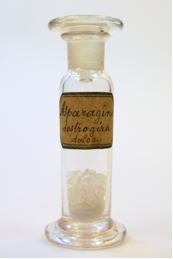The dextrorotatory sweet asparagine of Arnaldo Piutti: the original product is conserved in Florence

Published 2018-09-24
Keywords
- Asparagine,
- Chemical Heritage,
- history of enantioselectivity
How to Cite
Abstract
In 1886, Pasteur presented a note on the work of the Italian chemist Arnaldo Piutti concerning the difference between the two physical isomers (enantiomers) of asparagine. The octahedral crystal of asparagine appeared only as “levorotatory hemihedralism” but, in principle, should also exist as a dextrorotatory asparagine with a symmetric crystalline form. In 1886 Arnaldo Piutti isolated the dextrorotatory asparagines while he was working as an assistant of Ugo Schiff in Florence. He obtained also another unexpected information, of which only Pasteur immediately understood the importance: the dextrorotatory aspargine had a sweet taste. The dextrorotatory sweet asparagine of Arnaldo Piutti is conserved in the Schiff Collection of the Department of Chemistry “Ugo Schiff” at the University of Florence, and is the first compound where a relationship between the optical isomerism of a molecule and a different response of human receptors, in this case the taste, was observed.




